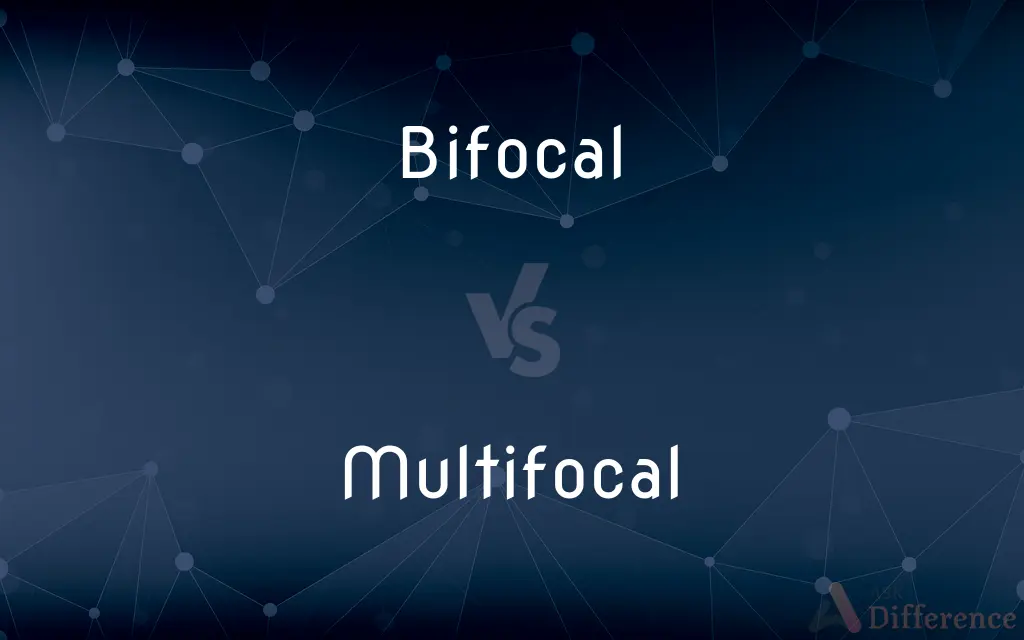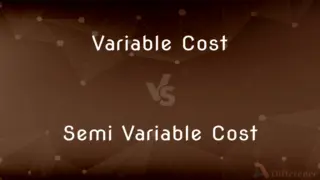Bifocal vs. Multifocal — What's the Difference?
By Tayyaba Rehman — Published on October 16, 2023
Bifocals are glasses with two distinct optical powers to assist with clear vision at both near and far distances. Multifocals are glasses that incorporate multiple optical powers to provide vision correction at various distances.

Difference Between Bifocal and Multifocal
Table of Contents
ADVERTISEMENT
Key Differences
Bifocal lenses are distinguished by having two distinct areas, each tailored for different viewing distances: one for near vision and another for far. On the flip side, multifocal lenses feature more than two prescription areas, crafted to provide clarity across multiple viewing distances, thereby aiding in seeing at near, intermediate, and far distances seamlessly.
Visibly, bifocal lenses traditionally exhibit a noticeable line or segment that separates the two lens powers, allowing wearers to switch their focus between two distinct viewing fields. Whereas multifocal lenses, especially progressive ones, lack these visible lines and offer a more gradual transition between the various prescription areas, providing a smoother visual experience from near to far.
For those who require correction for near and far vision, bifocals offer a simpler, typically less expensive solution that effectively addresses these two specific needs. Multifocal lenses cater to a wider array of visual needs but can be complex and may require a period of adjustment for the wearers due to the multiple viewing zones incorporated in them.
The bifocal lenses often are adopted by individuals who primarily require clear vision for reading and distance, providing a straightforward, two-zone solution. Conversely, multifocal lenses are often the choice for those requiring corrections at various distances, offering a more comprehensive, albeit sometimes pricier, visual solution.
When considering outdoor activities, bifocal sunglasses are available and are commonly used to assist with near and distance vision while outdoors. Multifocal sunglasses, offering corrections for all distances, are also available, providing a versatile, all-encompassing optic solution for an active, varied lifestyle outdoors.
ADVERTISEMENT
Comparison Chart
Prescription Areas
Two distinct prescription areas for near and far vision.
Multiple prescription areas for near, intermediate, and far vision.
Visual Transition
Typically has a visible line dividing the lens powers.
Smooth transition between different prescription areas, often with no visible lines.
Usage
Commonly used for clear near and distance vision.
Used for detailed vision at all distances.
Complexity
Simpler and often easier to adapt to.
Can be complex and might require an adaptation period.
Price Point
Generally more affordable due to simpler design.
Tend to be pricier due to the complexity in design.
Compare with Definitions
Bifocal
Bifocals traditionally have a visible line separating two viewing areas.
His bifocal glasses have a prominent line dividing near and far vision segments.
Multifocal
Multifocals, like progressives, provide a smooth transition between different viewing zones.
Multifocal lenses enabled a line-free, smooth visual transition from her laptop to distant presentations.
Bifocal
Bifocal sunglasses facilitate clear outdoor near and distance vision.
With bifocal sunglasses, he could read maps and view landscapes clearly on hikes.
Multifocal
Multifocals can be tailored to address multiple vision correction needs in one lens.
The multifocal lens catered to her near, intermediate, and distance vision requirements.
Bifocal
Bifocal lenses contain two optical powers in a single lens.
Bifocal glasses helped her read and see distant objects without changing eyewear.
Multifocal
Multifocal lenses have various prescription areas to assist viewing at different distances.
Multifocal glasses eased her transition from reading to computer work.
Bifocal
Bifocals aid users in switching focus between near and far distances.
She uses bifocal lenses to read books and watch television comfortably.
Multifocal
Multifocal sunglasses offer comprehensive vision correction for outdoor activities.
Her multifocal sunglasses provided clarity when reading outdoors and gazing into the distance.
Bifocal
Bifocals are often prescribed to address presbyopia.
The optometrist recommended bifocal lenses to manage his presbyopia effectively.
Multifocal
Multifocals may require a period of adaptation due to their complex nature.
Adjusting to multifocal glasses, she practiced moving her eyes to navigate different prescription areas.
Bifocal
]
Multifocal
Arising from or occurring in more than one focus or location.
Bifocal
Having two focal lengths.
Multifocal
(of an eyeglass lens) having several focusing areas that correct for both nearsightedness and farsightedness.
Bifocal
Having one section that corrects for distant vision and another that corrects for near vision, as an eyeglass lens.
Bifocal
Having two distinct goals or objects of attention
A bifocal approach to the problem.
Bifocal
(optics) Having two focal lengths
Bifocal
(of a correcting lens) Divided into two parts, one of which corrects for distance vision and the other for near vision
Bifocal
Having two foci, as some spectacle lenses.
Bifocal
A bifocal lens.
Bifocal
Having two foci;
Bifocal eyeglasses
Common Curiosities
Are the transitions between viewing areas in bifocal lenses smooth?
No, bifocals typically have a distinct line separating the two different focal areas.
What are bifocal lenses?
Bifocal lenses contain two distinct optical powers, one for distance vision and another for near vision, typically separated by a visible line.
Can bifocal lenses be used for reading and computer work?
Yes, the lower section aids near vision, which can be used for reading, while the upper section is for distance vision.
Are bifocal lenses available in different styles?
Yes, they come in various styles, including flat-top, round-segment, and executive, differing in the shape and size of the reading area.
What are multifocal lenses?
Multifocal lenses have multiple sections for correcting different vision zones (near, intermediate, and distance), providing a range of focal points.
Who typically uses bifocal lenses?
Bifocals are commonly used by individuals with presbyopia who require correction for both near and distance vision.
Who benefits from using multifocal lenses?
Multifocal lenses are typically used by individuals needing correction for multiple vision fields, often due to presbyopia.
Are multifocal lenses more expensive than bifocal lenses?
Generally yes, multifocal lenses, especially progressive lenses, tend to be more expensive due to their complex designs.
Which lens type offers a smoother transition between viewing distances?
Multifocal lenses, particularly progressive lenses, offer smoother transitions between different viewing areas without visible lines.
Is there a visible line on multifocal lenses?
In progressive multifocal lenses, there’s no visible line; the lens smoothly transitions between focal points.
How does one choose between bifocal and multifocal lenses?
The choice often depends on specific vision needs, budget, and personal preference, with input from an eye care professional.
Can both bifocal and multifocal lenses be used for all daily activities?
Yes, both lens types aim to provide clear vision for various activities, though multifocal lenses may offer broader versatility across multiple distances.
Can multifocal lenses accommodate more than two vision corrections?
Yes, multifocal lenses can address near, intermediate, and distance vision within a single lens.
Are multifocal lenses difficult to get used to?
Some individuals may require an adjustment period to become accustomed to the transitions between different focal zones.
What is the main difference between bifocal and multifocal lenses?
Bifocal lenses have two focal points (near and far), while multifocal lenses have multiple focal points (often near, intermediate, and far).
Share Your Discovery

Previous Comparison
Variable Cost vs. Semi Variable Cost
Next Comparison
Might vs. WillAuthor Spotlight
Written by
Tayyaba RehmanTayyaba Rehman is a distinguished writer, currently serving as a primary contributor to askdifference.com. As a researcher in semantics and etymology, Tayyaba's passion for the complexity of languages and their distinctions has found a perfect home on the platform. Tayyaba delves into the intricacies of language, distinguishing between commonly confused words and phrases, thereby providing clarity for readers worldwide.















































